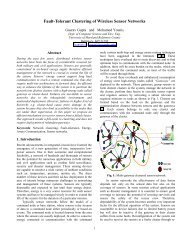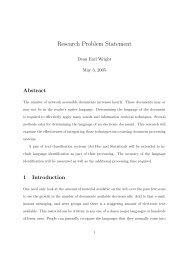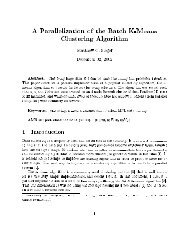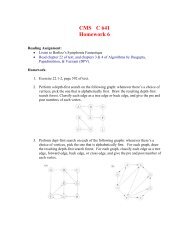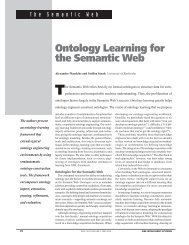Iterated Connectionless Server Algorithm
Iterated Connectionless Server Algorithm
Iterated Connectionless Server Algorithm
Create successful ePaper yourself
Turn your PDF publications into a flip-book with our unique Google optimized e-Paper software.
<strong>Iterated</strong> <strong>Connectionless</strong> <strong>Server</strong> <strong>Algorithm</strong><br />
1. Check a socket an bind to the address for the service being offered<br />
2. Repeatedly read the next request from a client, create a response, and send a reply<br />
back to the client according to the application protocol decided upon.<br />
Notes: In a connectionless server we cannot use the “connect” option described<br />
earlier. It must use an unconnected socket:<br />
retcode = sendto(s, /* descriptor of unconnected socket */<br />
message,<br />
len,<br />
flags, /* debugging and control options */<br />
toaddr, /* Structure containing address */<br />
toaddrlen)<br />
How does a server determine address of a client<br />
retcode = recvfrom(s, /* descriptor of unconnected socket */<br />
buf,<br />
len,<br />
flags, /* debugging and control options */<br />
from, /* Structure containing address */<br />
fromlen)<br />
Concurrency<br />
There is a need to provide faster response times to multiple clients. Response time is<br />
improved under the following situations:<br />
Forming a response requires significant I/O.<br />
Processing time can vary dramatically between requests<br />
<strong>Server</strong> executes on a computer with multiple processors<br />
Concurrent connectionless server algorithm<br />
Master 1:<br />
Master 2:<br />
Slave 1:<br />
Slave 2:<br />
Slave 3:<br />
Create a socket and bind to the address. Leave socket unconnected.<br />
Repeatedly call recvfrom to get next request from client and create a new<br />
slave thread (possibly in a new process) to handle the response.<br />
Begin with a specific request from the master (see Master 2 above) as well<br />
as access to the socket (i.e., receive access to socket).<br />
Form a reply according to the application protocol and send back to client<br />
using sendto<br />
exit, i.e., slave terminates after handling one request.
Concurrent connection-oriented server algorithm<br />
Master 1:<br />
Master 2:<br />
Master 3:<br />
Slave 1:<br />
Slave 2:<br />
Slave 3:<br />
Create a socket and bind to the address. Leave socket unconnected.<br />
Leave socket in passive mode, making it ready for use by a server.<br />
Repeatedly call accept to receive the next request from a client, and create<br />
a new slave thread or process to handle the response.<br />
Begin with a connection passed from the master (i.e., a socket for the<br />
connection).<br />
Interact with the client using the connection: use read & send.<br />
Close the connection and exit, i.e., slave terminates after handling all<br />
requests from one client.<br />
When to use each server type<br />
Iterative/Concurrent: Iterative servers are easier to design, implement, and maintain,<br />
but concurrent servers can provide quicker response to requests. Use an iterative<br />
implementation if request-processing time is short and an iterative solution produces<br />
response times that are sufficiently fast for the application.<br />
Real vs. apparent concurrency: A server that has a single thread of execution depends<br />
on asynchronous I/O to allow it to manage multiple connections. A multi-threaded<br />
implementation, whether multiple, singly-threaded processes or multiple threads within a<br />
single process, allows the OS to provide concurrency automatically. Use a single-thread<br />
solution if the cost of creating or switching among threads is high and the server must<br />
share or exchange data among connections. Use a multi-threaded solution, if the server<br />
must share or exchange data among connections and the cost of using threads is low. Use<br />
a multi-process solution if each slave can operate in isolation or to achieve maximal<br />
concurrency (e.g., on a multiprocessor).<br />
Connection-oriented vs. connectionless: Because connection-oriented access means<br />
using TCP, it implies reliable delivery; connectionless transport (UDP) implies unreliable<br />
delivery. Only use connectionless transport of the application protocol handles reliability<br />
or each client accesses its server on a local area network that exhibits extremely low loss<br />
and no packet reordering. Use connection-oriented transport whenever a wide area<br />
network separates the client and server. Never move a connectionless client and server to<br />
a wide area environment without checking to see if the application protocol handles<br />
reliability problems.<br />
Summary of server types<br />
Iterative, connectionless server: The most common form of connectionless server, used<br />
especially for services that require a trivial amount of processing for each request.<br />
Iterative servers are often stateless, making them easier to understand and less susceptible<br />
to failures.
Iterative, connection-oriented server: Less common. Used for services that require a<br />
trivial amount of processing for each request, bur for which reliable transport is<br />
necessary. Because the overhead associated with establishing and terminating<br />
connections can be high, the average response time can be non-trivial.<br />
Concurrent, connectionless server: An uncommon type in which the server creates a<br />
new thread or process to handle each request. On many systems, the added cost of thread<br />
or process creation dominates the added efficiency gained from concurrency. To justify<br />
concurrency, either the time required to create a new thread/process must be significantly<br />
less than the time required to compute a response or concurrent requests must be able to<br />
use many I/O devices simultaneously.<br />
Concurrent, connection-oriented server: It is the most general type of server because it<br />
offers reliable transport (i.e., it can be used across a wide area Internet) as well as the<br />
ability to handle multiple requests concurrently. Two basic implementations exist: the<br />
most common implementation uses concurrent processes or concurrent threads within the<br />
same process to handle connections; a far less common implementation relies on single<br />
thread and asynchronous I/O to handle multiple connections.<br />
In a concurrent process implementation, the master server thread creates a slave process<br />
to handle each connection. Using multiple processes makes it easy to execute a separately<br />
compiled program for each connection instead of writing all the code in a single, large<br />
server program.<br />
In the single-thread implementation, one thread of execution manages multiple<br />
connections. It achieves apparent concurrency by using asynchronous I/O. The server<br />
repeatedly waits fro I/O on any of the connections it has open and handles each request.<br />
Because a single thread handles all connections, it can share data among them. However,<br />
because it has only one thread, the server cannot handle requests faster than an iterative<br />
server, even on a computer that has multiple processors. The application must require<br />
data sharing or the processing time for each request must be short to justify this server<br />
implementation.
Figures<br />
The following figures illustrate some of the types of servers described in the previous<br />
pages.<br />
<strong>Server</strong> application process<br />
server<br />
OS<br />
socket at well-known port used for all communication<br />
Figure 1: Process structure for an iterative, connectionless server. A single thread of<br />
execution communicates with many clients using a single socket.<br />
<strong>Server</strong> application process<br />
server<br />
OS<br />
socket used for<br />
connection requests<br />
socket used for an<br />
individual<br />
connection<br />
Figure 2: Process structure for an iterative, connection-oriented server. A single thread of<br />
execution waits at a well-known port for a connection and then communicates with the<br />
client over that connection. Connection initiation is over another port.
<strong>Server</strong> application process<br />
Master<br />
slave<br />
slave<br />
slave<br />
OS<br />
socket used for<br />
connection<br />
requests<br />
sockets used for individual<br />
connections<br />
Figure 3: Process structure for an iterative, connection-oriented server. A single thread of<br />
execution waits at a well-known port for a connection and then communicates with the<br />
client over that connection. Connection initiation is over another port.<br />
<strong>Server</strong> application process<br />
<strong>Server</strong><br />
OS<br />
socket used for<br />
connection<br />
requests<br />
sockets used for individual<br />
connections<br />
Figure 4: Process structure of a connection-oriented server that achieves concurrency<br />
with a single thread. The thread manages multiple sockets.




